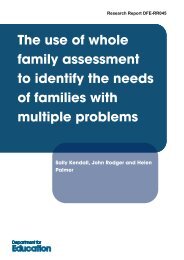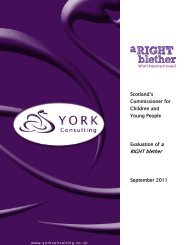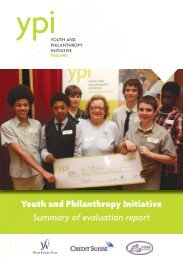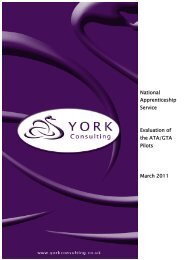Recruitment and Retention in the Post-16 Learning and Skills Sector
Recruitment and Retention in the Post-16 Learning and Skills Sector
Recruitment and Retention in the Post-16 Learning and Skills Sector
You also want an ePaper? Increase the reach of your titles
YUMPU automatically turns print PDFs into web optimized ePapers that Google loves.
6 WORKING IN THE SECTOR6.1 This section looks at characteristics of <strong>in</strong>dividuals work<strong>in</strong>g <strong>in</strong> <strong>the</strong> sector<strong>and</strong> issues fac<strong>in</strong>g <strong>the</strong>m. These issues have an impact both onrecruitment <strong>in</strong> <strong>the</strong> sense that people choose whe<strong>the</strong>r <strong>the</strong>y want to work<strong>in</strong> such a sector <strong>and</strong> on retention affect<strong>in</strong>g whe<strong>the</strong>r people want to stay<strong>in</strong> <strong>the</strong> sector. Issues are organised under <strong>the</strong> follow<strong>in</strong>g head<strong>in</strong>gs:• work<strong>in</strong>g practices;• amount of work;• resources <strong>and</strong> facilities;• future plans.Work<strong>in</strong>g Practices6.2 One <strong>in</strong> ten members of <strong>the</strong> workforce (546 respondents) does o<strong>the</strong>rregular paid work <strong>in</strong> addition to <strong>the</strong>ir ma<strong>in</strong> job. Most of those (72%, or7% of <strong>the</strong> ma<strong>in</strong> sample) have one additional job.6.3 Just under a third of respondents with multiple jobs <strong>in</strong>dicated that <strong>the</strong>ywork between 35 <strong>and</strong> 40 hours per week, <strong>in</strong>clud<strong>in</strong>g additional teach<strong>in</strong>gor teach<strong>in</strong>g related jobs (Table 6.1). Over a third of respondents work34 hours or less per week <strong>and</strong> a fur<strong>the</strong>r third (34%) work 41 hours ormore a week. Those with management responsibilities were more likelyto work longer hours.Table 6.1: How many hours <strong>in</strong> a st<strong>and</strong>ard work<strong>in</strong>g week do you usuallywork <strong>in</strong> total, <strong>in</strong>clud<strong>in</strong>g o<strong>the</strong>r jobs?%15 or less 9<strong>16</strong> – 24 1125 – 30 1131 – 34 435 – 40 3041 – 48 1848 or more <strong>16</strong>Base: 546 respondents, who have multiple jobsSource: YCL/MORI quantitative survey of teach<strong>in</strong>g/tra<strong>in</strong><strong>in</strong>g staff, 20056.4 In general, respondents had a wide range of experience both with <strong>the</strong>ircurrent employer <strong>and</strong> across <strong>the</strong> sector more generally (Figure 6.1).Around one-half of teachers/tra<strong>in</strong>ers (49%) had worked for <strong>the</strong>ir currentorganisation for five or more years <strong>and</strong> 47% had ten or more year’sexperience of work<strong>in</strong>g <strong>in</strong> <strong>the</strong> sector more generally.50











